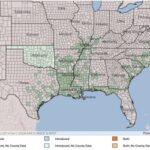Ludwigia glandulosa
Illustration courtesy of University of Florida/IFAS Center for Aquatic and Invasive Plants. Used with permission.
What is Cylindric-fruit Primrose?
Physical Characteristics
Leaves:
- Sword-shaped
- 0.59-3.94 inches long
- 0.16-0.79 inches wide
- Leaf stalk 0.078-0.39 inches long
Flowers:
Fruit:
- Cylindric-shaped
- Dry
- 0.08-0.31 inches long
- 0.06-0.08 inches thick
- Immobile
Seeds:
- Several indistinct rows
- About 0.024-0.028 inches long
Stem:
- Straight
- Well branched
- Up to 3 feet tall
Where Does it Grow?
USDA, NRCS. The PLANTS Database (http://plants.usda.gov). National Plant Data Team, Greensboro, NC 27401-4901 USA.
Cylindric-fruit primrose can be found in wet places such as ditches, swamps, marsh-meadows, shallow water, and in the mud on the edge of ponds, streams, and lakes.
Pros and Cons of Cylindric-fruit Primrose
Ducks and other waterfowl will consume the seeds of water primrose. Submerged portions of all aquatic plants provide habitats for many micro and macro invertebrates. These invertebrates in turn are used as food by fish and other wildlife species (e.g. amphibians, reptiles, ducks, etc). After aquatic plants die, their decomposition by bacteria and fungi provides food (called “detritus”) for many aquatic invertebrates.


